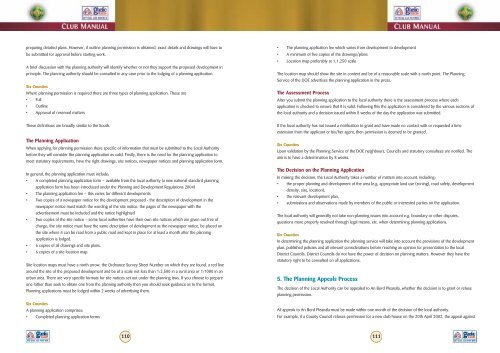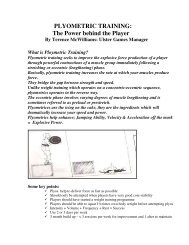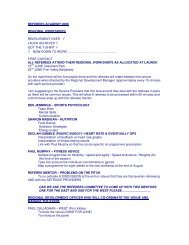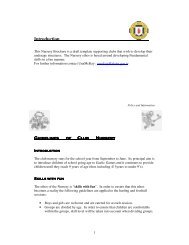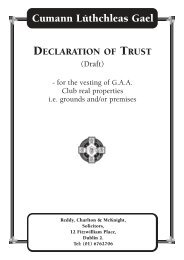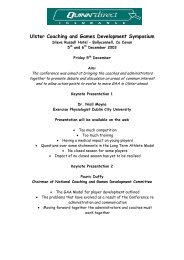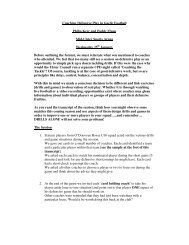Club Manual - Ulster GAA
Club Manual - Ulster GAA
Club Manual - Ulster GAA
Create successful ePaper yourself
Turn your PDF publications into a flip-book with our unique Google optimized e-Paper software.
preparing detailed plans. However, if outline planning permission is obtained, exact details and drawings will have to<br />
be submitted for approval before starting work.<br />
A brief discussion with the planning authority will identify whether or not they support the proposed development in<br />
principle. The planning authority should be consulted in any case prior to the lodging of a planning application.<br />
Six Counties<br />
Where planning permission is required there are three types of planning application. These are<br />
• Full<br />
• Outline<br />
• Approval of reserved matters<br />
• The planning application fee which varies from development to development<br />
• A minimum of five copies of the drawings/plans<br />
• Location map preferably at 1:1,250 scale<br />
The location map should show the site in context and be of a reasonable scale with a north point. The Planning<br />
Service of the DOE advertises the planning application in the press.<br />
The Assessment Process<br />
After you submit the planning application to the local authority there is the assessment process where each<br />
application is checked to ensure that it is valid. Following this the application is considered by the various sections of<br />
the local authority and a decision issued within 8 weeks of the day the application was submitted.<br />
These definitions are broadly similar to the South.<br />
The Planning Application<br />
When applying for planning permission there specific of information that must be submitted to the Local Authority<br />
before they will consider the planning application as valid. Firstly, there is the need for the planning application to<br />
meet statutory requirements, have the right drawings, site notices, newspaper notices and planning application form.<br />
In general, the planning application must include;<br />
• A completed planning application form – available from the local authority (a new national standard planning<br />
application form has been introduced under the Planning and Development Regulations 2004)<br />
• The planning application fee – this varies for different developments<br />
• Two copies of a newspaper notice for the development proposed - the description of development in the<br />
newspaper notice must match the wording of the site notice; the pages of the newspaper with the<br />
advertisement must be included and the notice highlighted<br />
• Two copies of the site notice – some local authorities have their own site notices which are given out free of<br />
charge; the site notice must have the same description of development as the newspaper notice, be placed on<br />
the site where it can be read from a public road and kept in place for at least a month after the planning<br />
application is lodged.<br />
• 6 copies of all drawings and site plans.<br />
• 6 copies of a site location map.<br />
Site location maps must have a north arrow, the Ordnance Survey Sheet Number on which they are found, a red line<br />
around the site of the proposed development and be of a scale not less than 1:2,500 in a rural area or 1:1000 in an<br />
urban area. There are very specific formats for site notices set out under the planning laws. If you choose to prepare<br />
one rather than seek to obtain one from the planning authority then you should seek guidance as to the format.<br />
Planning applications must be lodged within 2 weeks of advertising them.<br />
Six Counties<br />
A planning application comprises;<br />
• Completed planning application forms<br />
If the local authority has not issued a notification to grant and have made no contact with or requested a time<br />
extension from the applicant or his/her agent, then permission is deemed to be granted.<br />
Six Counties<br />
Upon validation by the Planning Service of the DOE neighbours, Councils and statutory consultees are notified. The<br />
aim is to have a determination by 8 weeks.<br />
The Decision on the Planning Application<br />
In making the decision, the Local Authority takes a number of matters into account, including:<br />
• the proper planning and development of the area (e.g. appropriate land use (zoning), road safety, development<br />
density, size, location),<br />
• the relevant development plan,<br />
• submissions and observations made by members of the public or interested parties on the application.<br />
The local authority will generally not take non-planning issues into account e.g. boundary or other disputes,<br />
questions more properly resolved through legal means, etc. when determining planning applications.<br />
Six Counties<br />
In determining the planning application the planning service will take into account the provisions of the development<br />
plan, published policies and all relevant considerations before reaching an opinion for presentation to the local<br />
District Councils. District Councils do not have the power of decision on planning matters. However they have the<br />
statutory right to be consulted on all applications.<br />
5. The Planning Appeals Process<br />
The decision of the Local Authority can be appealed to An Bord Pleanála, whether the decision is to grant or refuse<br />
planning permission.<br />
All appeals to An Bord Pleanála must be made within one month of the decision of the local authority.<br />
For example, if a County Council refuses permission for a new club house on the 20th April 2002, the appeal against<br />
110<br />
111


